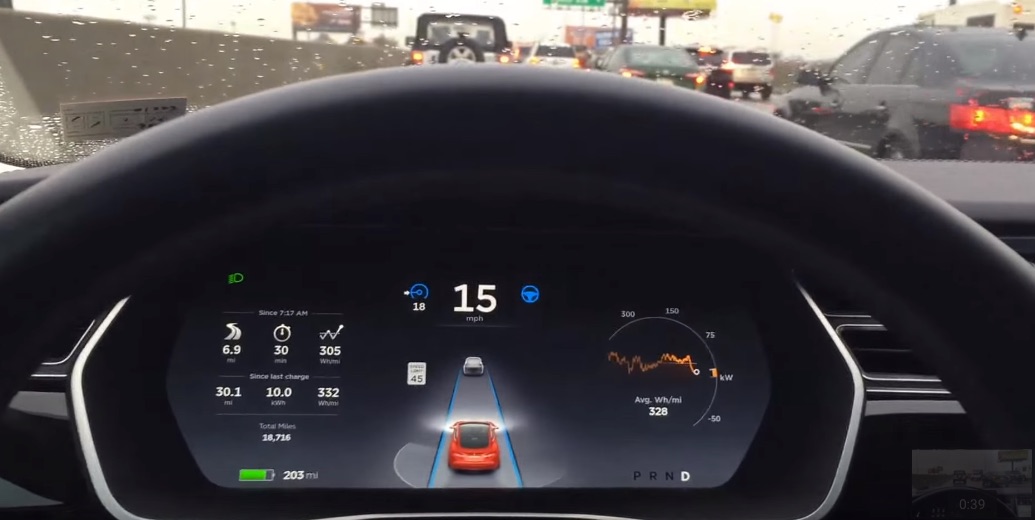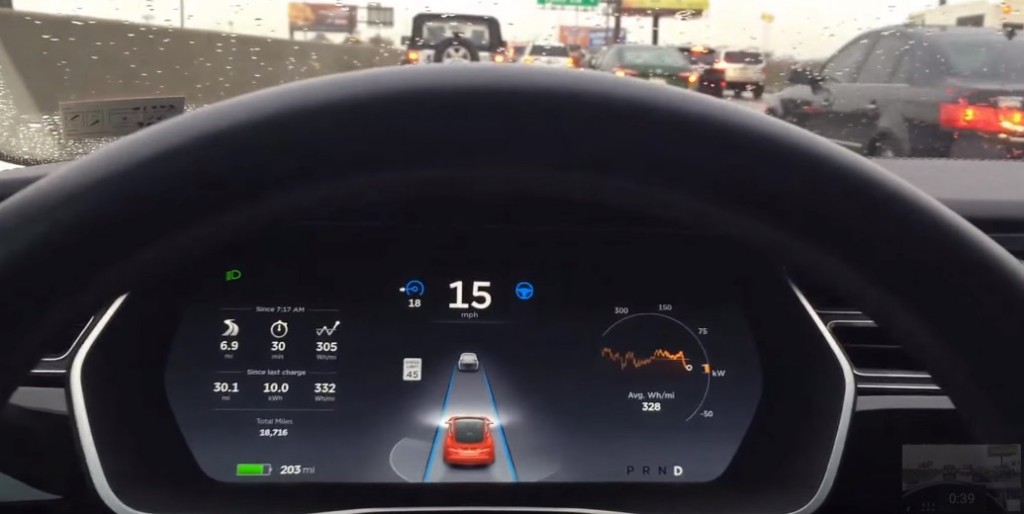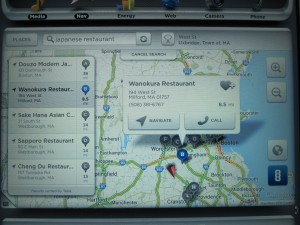News
How will Tesla Version 8 compare to current Autopilot in the real world?

Tesla’s upcoming Version 8 software will be the company’s most significant Autopilot upgrade since its October 2014 initial release, but how will these updates compare to current Autopilot behavior in the real world?
This will be the first time the company will switch from using the vehicle’s front-facing camera as the core hardware responsible for visual image recognition, to radar technology which will now become the primary sensor used in creating a virtual picture of the vehicle’s surroundings.
With these improvements, to be rolled out via an over-the-air software update in the coming weeks, Model S equipped with the Autopilot hardware suite and Model X should theoretically be able to handle emergency braking situations with more precision, provide a smoother Traffic Aware Cruise Control (TACC) experience, take highway exits on its own, and provide drivers and passengers with an overall safer experience.
Let’s take a look at each of these features and see how Autopilot in Version 8 will differ from current Version 7 capabilities.
Automatic Emergency Braking
Following the much publicized death of Joshua Brown after his Model S crashed into the side of a tractor trailer while driving on Autopilot, reliability of Autopilot’s Automatic Emergency Braking (AEB) feature was immediately put to question. Tesla released a statement stating that the high, white side of the tractor trailer, combined with a radar signature that would have looked very similar to an overhead sign, caused automatic braking not to fire. “Since January 2016, Autopilot activates automatic emergency braking in response to any interruption of the ground plane in the path of the vehicle that cross-checks against a consistent radar signature,” said Tesla.
Spy shots taken from the Naval Air Station reveal Tesla was testing and calibrating its AEB system this past summer. But despite the tests which seemingly show a Model S automatically braking in a staged collision event, Tesla has been overly cautious when it comes to activation of its AEB feature. AEB is reliant on imagery received from its front-facing camera, and supplemented by radar input, to decide on the degree of confidence that would trigger a braking event.
Some Tesla owners have even taken it upon themselves to stage scenarios that would seemingly trigger the AEB response of the vehicle, but to no avail leaving further mystery as to how AEB works.
The current Autopilot system under Version 7 is limited in its ability to reliably detect people or pinpoint false positives such as reflective objects that may appear larger than they are. Tesla uses the concave bottom of a soda can as an example. When the radar signal is reflected back from the can’s bottom dish-shaped surface, the reflected signal is amplified to many times its actual size leading the radar to believe there’s a large object before it. Because of that, programming the AEB system to suddenly engage could lead to a dangerous situation so Tesla decided to limit the scenarios that could actually trigger an automatic emergency braking response.
However, Version 8 will combine the power of fleet learning with “radar snapshots” to improve the vehicle’s ability to more accurately depict the circumstances of an event. In other words, we can expect Autopilot under Version 8 to have a much higher degree of confidence when it comes to engaging automatic emergency braking. Tesla CEO Elon Musk believes this set up will provide safety improvements by a factor of three over existing Autopilot.
Traffic Aware Cruise Control
Beyond being able to track a vehicle that’s directly in front of the car, Version 8 of Autopilot will also be able to see the vehicle ahead of that. Tesla describes this update as follows: Tesla will also be able to bounce the radar signal under a vehicle in front – using the radar pulse signature and photon time of flight to distinguish the signal – and still brake even when trailing a car that is opaque to both vision and radar. The car in front might hit the UFO in dense fog, but the Tesla will not.
The improvement will lead to smoother braking events when TACC is engaged since Autopilot will no longer solely rely on the actions from the vehicle before it. If a hard braking event happened in front of the vehicle that Autopilot is immediately tracking, Version 8 will be able to identify it and slow the Model S (or Model X) even before the vehicle directly ahead may have applied the brakes.
The following video captures an incident whereby the vehicle being tracked by Version 7 of Autopilot could not see the hard braking event that took place two cars ahead. TACC seemingly did not have enough time to stop the Model S.
Being able to see two cars ahead in Version 8 will provide a smoother TACC experience and increased safety.
Improved Auto Lane Change and Freeway Exiting
What we’re particularly excited about is the new feature in Version 8.1 that will allow an Autopilot-equipped Model S and Model X to take highway exits using the onboard navigation system.
Currently, Version 7 of Autopilot is capable of handling lane changes when the driver explicitly uses the turn signal stalk. Signaling left and the vehicle will make a left lane change, and vice versa. However with the ability to punch in a destination through Tesla Nav and have the vehicle assist with freeway exiting, assuming that’s part of the route, in our minds, Tesla is taking a critical step towards the ultimate goal of building fully autonomous self-driving vehicles. It’s a small step, but nonetheless it’s a notable step.
Photo credit: Rob M.
Full details of Tesla Version 8 can be found here.

Elon Musk
Elon Musk and Tesla AI Director share insights after empty driver seat Robotaxi rides
The executives’ unoccupied tests hint at the rapid progress of Tesla’s unsupervised Robotaxi efforts.

Tesla CEO Elon Musk and AI Director Ashok Elluswamy celebrated Christmas Eve by sharing personal experiences with Robotaxi vehicles that had no safety monitor or occupant in the driver’s seat. Musk described the system’s “perfect driving” around Austin, while Elluswamy posted video from the back seat, calling it “an amazing experience.”
The executives’ unoccupied tests hint at the rapid progress of Tesla’s unsupervised Robotaxi efforts.
Elon and Ashok’s firsthand Robotaxi insights
Prior to Musk and the Tesla AI Director’s posts, sightings of unmanned Teslas navigating public roads were widely shared on social media. One such vehicle was spotted in Austin, Texas, which Elon Musk acknowleged by stating that “Testing is underway with no occupants in the car.”
Based on his Christmas Eve post, Musk seemed to have tested an unmanned Tesla himself. “A Tesla with no safety monitor in the car and me sitting in the passenger seat took me all around Austin on Sunday with perfect driving,” Musk wrote in his post.
Elluswamy responded with a 2-minute video showing himself in the rear of an unmanned Tesla. The video featured the vehicle’s empty front seats, as well as its smooth handling through real-world traffic. He captioned his video with the words, “It’s an amazing experience!”
Towards Unsupervised operations
During an xAI Hackathon earlier this month, Elon Musk mentioned that Tesla owed be removing Safety Monitors from its Robotaxis in Austin in just three weeks. “Unsupervised is pretty much solved at this point. So there will be Tesla Robotaxis operating in Austin with no one in them. Not even anyone in the passenger seat in about three weeks,” he said. Musk echoed similar estimates at the 2025 Annual Shareholder Meeting and the Q3 2025 earnings call.
Considering the insights that were posted Musk and Elluswamy, it does appear that Tesla is working hard towards operating its Robotaxis with no safety monitors. This is quite impressive considering that the service was launched just earlier this year.
Elon Musk
Starlink passes 9 million active customers just weeks after hitting 8 million
The milestone highlights the accelerating growth of Starlink, which has now been adding over 20,000 new users per day.

SpaceX’s Starlink satellite internet service has continued its rapid global expansion, surpassing 9 million active customers just weeks after crossing the 8 million mark.
The milestone highlights the accelerating growth of Starlink, which has now been adding over 20,000 new users per day.
9 million customers
In a post on X, SpaceX stated that Starlink now serves over 9 million active users across 155 countries, territories, and markets. The company reached 8 million customers in early November, meaning it added roughly 1 million subscribers in under seven weeks, or about 21,275 new users on average per day.
“Starlink is connecting more than 9M active customers with high-speed internet across 155 countries, territories, and many other markets,” Starlink wrote in a post on its official X account. SpaceX President Gwynne Shotwell also celebrated the milestone on X. “A huge thank you to all of our customers and congrats to the Starlink team for such an incredible product,” she wrote.
That growth rate reflects both rising demand for broadband in underserved regions and Starlink’s expanding satellite constellation, which now includes more than 9,000 low-Earth-orbit satellites designed to deliver high-speed, low-latency internet worldwide.
Starlink’s momentum
Starlink’s momentum has been building up. SpaceX reported 4.6 million Starlink customers in December 2024, followed by 7 million by August 2025, and 8 million customers in November. Independent data also suggests Starlink usage is rising sharply, with Cloudflare reporting that global web traffic from Starlink users more than doubled in 2025, as noted in an Insider report.
Starlink’s momentum is increasingly tied to SpaceX’s broader financial outlook. Elon Musk has said the satellite network is “by far” the company’s largest revenue driver, and reports suggest SpaceX may be positioning itself for an initial public offering as soon as next year, with valuations estimated as high as $1.5 trillion. Musk has also suggested in the past that Starlink could have its own IPO in the future.
News
NVIDIA Director of Robotics: Tesla FSD v14 is the first AI to pass the “Physical Turing Test”
After testing FSD v14, Fan stated that his experience with FSD felt magical at first, but it soon started to feel like a routine.

NVIDIA Director of Robotics Jim Fan has praised Tesla’s Full Self-Driving (Supervised) v14 as the first AI to pass what he described as a “Physical Turing Test.”
After testing FSD v14, Fan stated that his experience with FSD felt magical at first, but it soon started to feel like a routine. And just like smartphones today, removing it now would “actively hurt.”
Jim Fan’s hands-on FSD v14 impressions
Fan, a leading researcher in embodied AI who is currently solving Physical AI at NVIDIA and spearheading the company’s Project GR00T initiative, noted that he actually was late to the Tesla game. He was, however, one of the first to try out FSD v14.
“I was very late to own a Tesla but among the earliest to try out FSD v14. It’s perhaps the first time I experience an AI that passes the Physical Turing Test: after a long day at work, you press a button, lay back, and couldn’t tell if a neural net or a human drove you home,” Fan wrote in a post on X.
Fan added: “Despite knowing exactly how robot learning works, I still find it magical watching the steering wheel turn by itself. First it feels surreal, next it becomes routine. Then, like the smartphone, taking it away actively hurts. This is how humanity gets rewired and glued to god-like technologies.”
The Physical Turing Test
The original Turing Test was conceived by Alan Turing in 1950, and it was aimed at determining if a machine could exhibit behavior that is equivalent to or indistinguishable from a human. By focusing on text-based conversations, the original Turing Test set a high bar for natural language processing and machine learning.
This test has been passed by today’s large language models. However, the capability to converse in a humanlike manner is a completely different challenge from performing real-world problem-solving or physical interactions. Thus, Fan introduced the Physical Turing Test, which challenges AI systems to demonstrate intelligence through physical actions.
Based on Fan’s comments, Tesla has demonstrated these intelligent physical actions with FSD v14. Elon Musk agreed with the NVIDIA executive, stating in a post on X that with FSD v14, “you can sense the sentience maturing.” Musk also praised Tesla AI, calling it the best “real-world AI” today.











